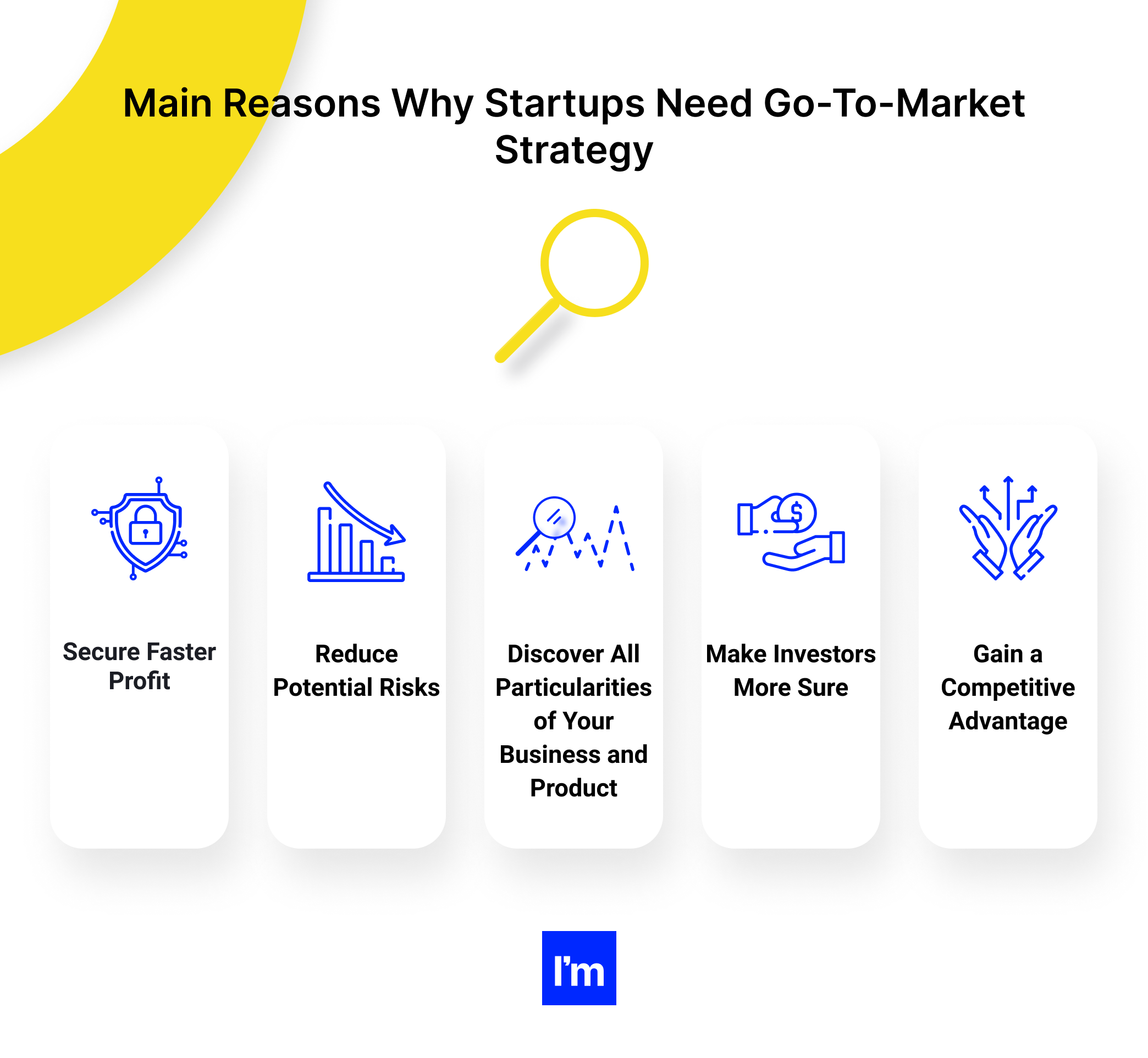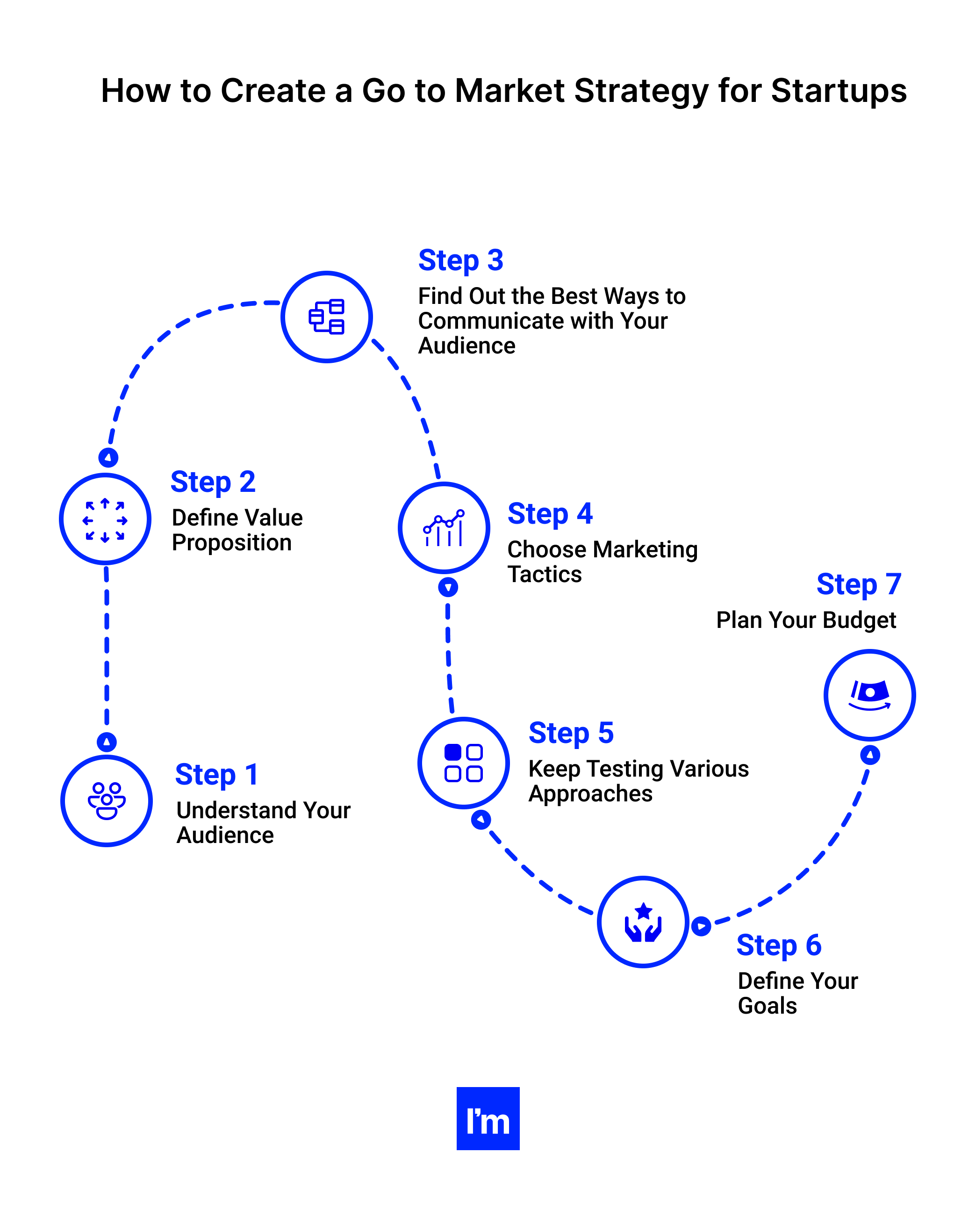According to statistics, 90% of all startups fail. 21.5% of companies suffer failure during the first year of their existence, 30% of companies fail during the second year and 50% of companies manage to stay afloat for only 5 years.
You may have the best product in the world but who cares if no one knows about its existence? The profit of your IT product will depend heavily on how well you can present it, whether you can reach the target audience and how you plan your budget on advertising. Startups have it even more difficult. They are not well known yet so they need to put even more effort into marketing. At the same time, they have a limited budget and from small to no marketing teams. Unluckily, web and mobile developers rarely have a clue about marketing and will not assist you with go-to-market strategy without prior research.
In this guide, we want to shed some light on go to market strategy for startups.
We will explain what's a go to market strategy, explore why startups need a good GTM strategy in place, and how to create it. In order to make things even more straightforward and easy, we have created a template that you can tailor to the specifics of your startup.
What is the GTM Strategy?
GTM strategy stands for go-to-market strategy and it is exactly what it sounds, a strategy of entering the market. It may be about product launches, expanding to new markets, or even the announcement of new features. Businesses prepare their distribution and sales in order to reach their target audience and convince them to buy the new product.
GTM strategy consists of three pillars:
- what product you offer
- who your target audience is
- how you will connect those two aspects
Marketing strategy is a natural continuation of a GTM strategy. The latter focuses on launching the product and growing the audience from zero to something. Marketing strategy comes in when the part of the audience is reached. It focuses on long-term goals and engaging with existing customers and beyond.
Main Reasons Why Startups Need Go-To-Market Strategy
A quality go-to-market strategy framework requires some research, thinking, planning, and other time-consuming tasks on your part. Is it really worth the effort?

We think that it is! There are main reasons to create a go-to-market strategy for your startup:
Secure Faster Profit
Results are extremely important in startups. The sooner you can prove that your idea is working and pulling in revenue, the better.
GTM strategy helps you to launch your product, get noticed by the audience, and get first profits way faster. You will have a detailed plan in place and it will be less scary and tiresome to decide what to do on the spot.
Reduce Potential Risks
There are already too many risks in startups, it will be a waste to avoid all of them and get hit by failure in marketing. Business strategists will shed a tear looking at messy efforts of distributions and money spent on ineffective advertisement.
With a GTM strategy in place, you will have a detailed plan with well-thought-out steps. During the creation of the strategy, you will have to do a lot of research and data analysis so you can stop guessing and start making informed decisions. The latter is less likely to flop and cause budget extensions.
Discover All Particularities of Your Business and Product
If you have never developed a business plan or it was quickly written for investors to calm down, the GTM strategy creation is the perfect time to actually think about your product. You will identify what is unique about the product, who your potential users are and where to find them.
It will also be easier to sell the product later: you will already know the value proposition and pain point of the customers.
Make Investors More Sure
If you have everything planned in advance and your idea goes beyond the creation, you are more likely to attract investors. Funding consultants will probably ask you to prepare a GTM anyways since the questions about distribution often come up during pitches.
Gain a Competitive Advantage
Not many startups dedicate time and resources to developing a detailed go-to-market strategy. So, by creating one for your business, you would be able to stand out among your competitors. During the GTM strategy creation, it is of crucial importance to profoundly analyze the market and your competitors to discover their strong and weak points.
How to Create a Go to Market Strategy for Startups?
We hope that the benefits got you all motivated to dive deep into GTM strategy creation.
This section is a step-by-step guide for building a GTM strategy that matters.

Step 1: Understand Your Audience
You do not have to offer your product to every person on the planet. It is a total waste of effort and budget. A smarter decision is to understand who your typical customers/users are and what their typical behavior is. It takes less time and effort to attract potentially interested customers. Moreover, 76% of modern consumers expect businesses to understand their desires and expectations. So conducting deep research of your target audience is of crucial importance today.
In order to find out more about your target audience and their behavior, you can:
Conduct Interviews
This method is the most time-consuming but it provides the most accurate and rich results. During the conversations, the most unexpected insights can be revealed since it is not as standardized and flows more naturally. Ask your potential users about what they are lacking or find annoying, what communication channels they prefer, and how they see a perfect service or product provider.
Distribute Questionnaires
Questionnaires allow you to reach more diverse audiences and find out more pain points and behavior patterns. You will also better understand whether some pain points are individual or collective to give priorities to the latter.
In order to encourage prospects to fill in the questionnaire, make it anonymous, keep it short, and offer some small prizes in return.
Review Studies and Researches From Other Companies
It involves the least effort. However, you will have to pay for the research results and still end up with irrelevant data. Therefore, you may use this method as a starting point of your target audience research but you should never rely fully on it.
In the end, you have to know this kind of information:
- age
- location
- job and income
- pain points
- preferred devices
- factors that make them buy
Do not forget to segment your audience in buyer personas. For example, health tech will probably be used by doctors and patients, their age will be somewhere between 20 and 50. It is a huge audience and all of them have different preferences and pain points. Ad copy for every group of people will vary dramatically.
If you are creating a B2B product, the audience must be separated into groups as well, from people in the finance department who will be interested in the costs and profit to end-users who will mostly be interested in the functionality.
Step 2: Define Value Proposition
Value proposition stands on three pillars:
- relevancy or how your product solves the problems of prospects
- value or what benefits your product delivers to prospects, how it can improve their lives or workflow
- differentiation or why you are better than your competitors, what is unique about your product
Therefore, no, the value proposition is not about listing the features. For example, you can turn “face ID” into “security with fewer steps provided by face ID”. Explain that users do not have to worry about entering at least 4 digits before unlocking the phone but their phone still will be protected. Do not hesitate to reach out to software consultants with the question of value propositions. They may help you to understand your product better not only in terms of features but in terms of their usefulness as well.
The typical value proposition has a catchy headline, 2-3 sentence paragraph with what you offer to who, bullet points with main benefits, and a clean visual.
Remember what language your audience speaks as well. Never throw in way too many tech words for users that are not tech-savvy: complex concepts will just push them away and think of you as an arrogant brand.
Step 3: Find Out the Best Ways to Communicate with Your Audience
Communication channels depend on your target audience, their demographics, and job positions specifically. For example, younger generations are likely to see your ad on Instagram or TikTok but you are unlikely to reach them through Facebook. Those working in politics can be easily found on Twitter or Facebook but they will probably not spend that much time on Instagram.
Some channels that you can consider are:
- blogs
- physical locations
- events (both offline and online lectures, hackathons, webinars)
- social media pages of your startup
- ads on social media platforms and Google
- partnerships with influencers or respected brands in your niche
- email marketing
You may also consider implementing an omnichannel approach to communicating with your users. On average, companies offering omnichannel customer experience retain 89% of their customers, and companies that haven’t implemented this approach retain only 33% of their audience.
Step 4: Choose Marketing Tactics
Some groups of people hate pop-ups and others will never trust paid partnerships. Therefore, based on who your audience is, you can choose between:
Referral Programs
If people recommend your product to other people, they get some bonuses. That is what referral programs are about. However, you have to deliver a product of high quality because referrals are actually recommendations. If there are some problems with the product, users will not want to lose the respect of their friends or family and will not recommend the solution.
Content Marketing
Content marketing helps organizations to establish themselves as authorities in their industries, prove the value of their product with more than just an ad copy, and retain customers better. It does involve more effort but it is one of the most effective ways to reach wider audiences and build a strong connection with them.
Moreover, the content will help your page to rank higher in searches and you can get organic traffic that you do not have to pay for.
Advertisement
It is one of the most popular marketing tactics. It involves an average amount of effort and helps to reach quick results. Advertisements can run on Google, Facebook, Twitter, or any other social media platform out there.
Social Media Presence
People like to interact with brands online. They like to see creative campaigns, competitions, and giveaways. They want to know what you have to offer except for product: what kind of people work in your startup, what stories your brand has to tell, how they interact with subscribers.
Step 5: Keep Testing Various Approaches
Unfortunately, even the most researched theories need testing to prove them. Before you go big with your ads or other forms of marketing, test everything that you assume into practice. Create different ad copies and see what performs better. Go for different marketing tactics and see what brings the most conversions or brand visibility. Show ads to different target audiences to feel your real audience. Experiment with different messages.
If you let yourself be creative, test, and learn from your mistakes, you will not have to spend tons of money on ineffective campaigns. Make sure to analyze thoroughly the results of small campaigns to get the most out of bigger ones.
Step 6: Define Your Goals
It is much easier to work towards feasible aims and actually achieve them. If your aim is to launch successfully, you are unlikely to do so. What is successful for you? What does success mean for your team? What is success in the industry?
Set more specific aims like getting 1,000 subscriptions or get 20,000 impressions on your ad campaign or have 200 monthly visitors on your blog. It will help you to stay focused and work harder. However, do not set unrealistic goals because you will end up with regrets and a lack of motivation for everyone on the team.
Step 7: Plan Your Budget
Take a look at the results of the testing. Define what marketing tactic brings more conversions and sales and consider giving it the most budget. If a tactic works badly, it does not mean that you have to drop it immediately: it may be the only possible way to reach a part of your audience. Just assign less spending on it and let it bring you some revenue.
In order to help you with market research, we’ve created a go-to-market strategy template that you can download for free and use for business planning. Download the template now, fill in all the fields and make the first step to creating a top-notch GTM strategy.
%20(1)-png.png)
Examples of Real-Life GTM Strategies
Every big name in the world has started somewhere: they all tried to understand marketing and find their customers. So everyone has been there, done that.
Let’s take a look at how brands launched their products and features, entered the new market, gained competitive age, and began small to grow big.
Huawei
Huawei was entering an Indian market and have faced these problems:
- disrespect towards Chinese products because they have bad quality
- bad diplomatic relationships between India and China
- belief that China only takes and does not give
- idea that it is too hard to work with Chinese companies
In order to be unique and break the stereotypes, the company has established research and development centers in India and gave jobs to locals mainly. They also work with English Language channels to help locals learn the language and go international. They focused on the unique characteristics of their brand and established strong relationships in the market that were initially unwelcoming.
TaxJar
TaxJar turned into a tax company over time since users did not see them as a tech company only. They were the first to educate people about sales tax in an accessible, easy-to-understand language. Through content marketing, they established themselves as an authority and won over thousands of previously confused users. Only after TaxJar explained sales tax, they were able to explain how their tech product is useful and managed to make it popular.
UpScope
UpScope is a quick screen-sharing tool. Nothing new, huh? By the time that they arrived on the market, there were thousands of such solutions that were perfected. What did they do to beat the well-established competitors?
They found a new audience to target. Unlike other companies who have focused on business meetings and common users overall, they targeted tech support teams and onboarding teams. They knew their pain points very well: support teams had to blindly guide users with texts or calls and hope that customers pressed the right buttons. It took a lot of time because they may have understood only midway that the customer is on the wrong tab or have no idea where they are overall.
UpScope promised quick screen-sharing with one click and a reduction in calls or chat duration by 30% through easier user navigation and more visual explanations. They used content marketing and partnerships with live chat companies as their main marketing tactics and it worked!
VSCO
GTM strategies are not always about launching new products or entering new markets. Sometimes it is about introducing new features.
VSCO introduced a new montage feature during the pandemic and they turned it into a tool of helping users overcome these uncertain times. They stated the pain point: the pandemic is difficult, uncertain, and lonely. They instantly gave the solution: connect with other people through your stories, let them know your perspective on the situation, and let them see how these challenging times can be also beautiful.
They used email marketing, push notifications in the app, and their social media platforms to spread a strong message.
Tesla
Tesla started with an electric sports car. It is a tiny niche whose target audience was people who did not care about the price that much but were intrigued by electronic novelty. Tesla knew that at the time they could not withstand the competition in larger niches. With revenue from that small niche, they managed to invest in expansions and have grown bigger.
Therefore, you do not have to aim at the gigantic results at first. Do what you can to help you survive and declare about yourself to later move to a larger scale.
How to Choose The Right GTM Strategy?
There are literally no wrongs or rights in GTM strategy building. Every strategy is completely individual to industry, niche, and product.
One of the best ways to choose a GTM strategy is to collect ideas but create your own strategy based on the research, analysis, and testing that you have made. Do not forget to also understand what resources you have and decide on either survival or development mode.
One of the worst ways to choose a GTM strategy is to copy it fully from others. One of the greatest strategies that did wonders to one brand may turn a startup into a big fat failure. Follow the steps that we have mentioned above and you will get to the unique strategy yourself.
Summary
GTM strategy is important for startups that aim at a great start and want to avoid unnecessary risks. There are 7 steps between you and the perfect product launch or market entering.
GTM strategy defines who your target audience is, what their problem is, how your product solves it, and how you will tell them about the solution. It also involves research and a lot of testing.
Does it sound too complicated? Do you want a great launch but do not have enough tools, knowledge, or time? Ideamotive is here to help! Our network of tech and business professionals will go through GTM strategy building with no stress for you and deliver impressive results. Start your product launch as great as it can get!




%20(1)-png.png)







